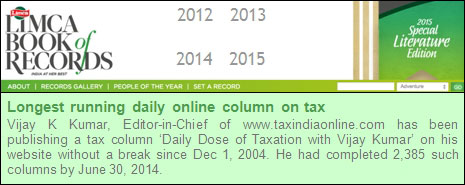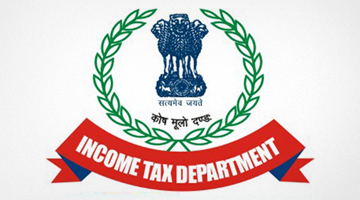No Coercive Action on MAT Cases - CBDT

12 05 2015
Tuesday
THE CBDT in a Press Release states,
Finance Minister has, while responding to the discussions on the Finance Bill in Rajya Sabha on 7th May, 2015 announced constitution of a Committee headed by Justice A.P. Shah to look into, inter alia, the issue of MAT on FIIs. The Committee is expected to give its report on this issue expeditiously.
In the light of FM's announcement, officers dealing with International Taxes have been advised that no coercive action be taken for recovery of demand already raised by invoking provisions of MAT in the cases for foreign companies. Issues of fresh notices for reopening of cases as also completion of assessment should also be put on hold unless the case is getting barred by limitation .
In his budget speech, the Finance Minister said, In order to rationalise the MAT provisions for FIIs, profits corresponding to their income from capital gains on transactions in securities which are liable to tax at a lower rate, shall not be subject to MAT. But the amendment to the Act is to come into effect from 1st April 2016. This gave the much needed strength to the Department to issue Show Cause Notices to FIIs for the period prior to AY 2016-17. The theory that was circulated was that prospective exemption made it clear that there was tax liability for the past period. And what followed was perhaps one of the most watched fiscal dramas. The FIIs cried foul, the stock markets crashed, analysts took sides and loudly proclaimed their views. Even the FM announced that India is not a tax haven and whatever taxes are due have to be paid. Then they clarified that MAT provisions are not applicable to FIIs covered under the DTAA. Last week the Finance Minister announced in the Parliament that he was referring the matter to Justice AP Shah and now the CBDT puts on hold notices and recovery.
All fine, but are we not going in the wrong direction? When they announced the exemption in the Budget 2015, didn't the babus know that the question of taxability for the previous years would be an issue? Couldn't they clarify then itself that the exemption is only prospective and tax has to be paid for the past years? And what is the logic in exempting a tax from tomorrow, but taxing it yesterday, especially when yesterday you were not aware that it was taxable? Till this exemption was given, even the Government was not clear whether this tax was leviable. On the whole, they gave a lot of bad publicity to the Finance Minister and the Modi Government, as businessmen went around talking about India's tax terrorism. Taxing or not is your decision, but please be sure about it - don't confuse the foreigners as you have been confusing Indians all these years and making a fine art of litigation.
Poor Finance Ministers have to take the blame for the follies of babudom.
CBDT Press Release dated May 11 2015
CBDT wants 25 lakh new assessees per month
THE CBDT Chairperson Ms Anita Kapur in a letter to the Principal Chief Commissioners and Principal DGs states:
- The number of existing income tax payers is low compared to the potential.
- The gap between the potential and the actual tax payers appears to be wider in the case of tier-II cities and towns.
- Considering the priorities of the Government and the need to widen the tax base, a concerted and focused effort in mission mode is required.
- We have to strive for adding at least 25 lakhs new assesses per month during the current financial year.
- The strategy to achieve the target of adding at least 25 lakhs new assessees per month during the current financial year is slated to be one the thrust areas of the Annual Conference of Pr.CCsIT/Pr.DsGIT/CCsIT/DsGIT scheduled to be held on 25-26 May 2015 at New Delhi.
She wants them to come prepared to present and discuss specific strategies for widening the tax base of their own region and at national level.
CBDT F.No. 282/11/2015-IT(Inv.V)/72., Dated May 08 2015
Customs - Directorate General of Valuation - through Audit
THE Directorate of Valuation (DOV) was established in the year 1997 and upgraded as Directorate General of Valuation (DGOV) in December 2002. The main function of the DGOV is to assist the Central Board of Excise & Customs in Policy matters concerning valuation of Imported, exported and excisable items; developing valuation tools and best practices for the effective and uniform application of valuation law; monitoring valuation trends of sensitive commodities; carrying out valuation inspections at Customs stations; coordinating with relevant international organizations; providing data for Risk Management System(RMS); monitoring and examining quality of orders passed by Special Valuation Branches (SVBs) of the Customs Commissionerates, etc. DGOV in its website (www.dov.gov.in) hosts the National Import Database (NIDB), Central Excise Valuation Data Base (CEDB), Central Registry of Special Valuation cases (SVB), Export Commodity Database, alerts and monthly Valuation Bulletin "Customs Valuation Bulletin" as well as "Central Excise Valuation Bulletin" are published and disseminated. The website also shows the organizational structure of DGOV. From December 2012, the functional control of Special Valuation Branches at Mumbai, Delhi, Chennai, Kolkata and Bangalore were delegated to DGOV.
Recently, the CAG conducted an audit over the functioning of Directorate General of Valuation and the DGOV was far more cooperative than the DG DRI. (Please see yesterday's DDT)
National Import Data Base (NIDB) : An electronic data base of imported goods has been developed in June 2004 which involves compilation of import data on weekly basis from all Customs stations in the country and its analysis by specially developed software (Mulyaankan) to determine outliers; unit values, weighted average values of identical goods, percentage deviations and outliers, supplemented with international price information.
Export Commodity Data Base (ECDB): It is an export valuation data base, developed in the year 2005 with a view to check over/under valuation and misuse of export incentive schemes. This involves capturing of export data from the Customs Stations, consolidation and analysis of this data with the help of a specially designed software for providing results (viz. weighted averages, standard deviations, outliers), leading to detection of potential cases of valuation fraud.
Central Registry Database (CRD): CRD is maintained by DGOV on its website which contains details of Special Valuation Branch (SVB) cases pertaining to related party imports, payment of royalties, license fees, supply of materials and services by the importer, etc. registered in the five major Custom Houses at Mumbai, Chennai, Delhi, Kolkata and Bangalore. Each case registered under SVB has to be uploaded in the CRD by the respective Custom House. DGOV has been vested with functional control over the SVBs with effect from 1 January 2013.
Central Excise Valuation Database (CEDB): Central Excise Valuation database has been developed in respect of 9 sensitive commodities being received from the central excise zones with effect from July 2008 and being analyzed. A monthly report is generated containing the average, maximum and minimum assessable values for different commodities.
CAG noticed that DGOV:
1. does not have any IS Strategic Plan for Database Management System of DGOV.
2. has not conducted the audit of its software.
3. does not capture the number of hits in the system
4. does not have the exact number of outliers generated for the commodities at a point of time (at eight digit level).
CAG recommended:
i. Independent third party evaluation/assessment.
ii. An IS organization within DGOV with the right skilled persons.
iii. Audit of the database, operating system, networking, infrastructure, hardware configuration, IS security, change management etc.
Non integration of DGOV databases with Indian Customs EDI System (ICES) 1.5 : DGOV data base is not integrated with ICES 1.5. Assessing officer has to login to the DGOV website and separately search for the required information. CBEC had directed its field formations on 28th November 2009 to use of DGOV databases while assessing import bill of entries or shipping bills by integrating it with ICES 1.5.
How correct is DGOV Data ? Audit of the value of imports and exports of all commodities from DGOV, compared with the data reported by MOCI indicated that total value of imports in DGOV database was less to the extent of 35.58 percent, 39.06 percent and 33.53 percent for the year 2011-12, 2012-13 and 2013-14 respectively in comparison to value of imports as published by MOCI which also relies on the ICES 1.5 data. Similarly total value of export in DGOV database was less to the extent of 27.53 percent in the year 2012-13 and 34.06 percent in the year 2013-14.
The main reasons for the difference appear to be non-inclusion of data of imports/exports made by Special Economic Zones (SEZs/EOUs) in DGOV database and non-existence of any mechanism with DGOV to ensure that data receipt in DGOV is complete.
DGOV also informed that assessments of imports and exports in SEZs are handled by MOCI and their system was not connected with Customs EDI systems. It was observed that alerts issued by the DGOV are not being marked by DGOV to the Development Commissioners of SEZs which was confirmed by Development Commissioner, SEEPZ.
It is indeed surprising that in spite of all these deficiencies, the DGOV continues to be in the business!
Please also see TARC recommendations - 'Beginning of end' for SVB?
Jurisprudentiol - Recent SC Judgement
Central Excise - Classification - fixed dose combination of Vitamin B-1, B-6 and B-12 injectible as well as tablets form - The goods were classified under Chapter Heading 2936.00 by Delhi Bench of CESTAT, accepting the case of the Revenue; Mumbai Bench classified these very goods under Heading 3003.10 as claimed by the assessee. Both are in appeal before the Supreme Court. In the meanwhile Larger Bench of the CESTAT classified the product under 3003.10. Department did not appeal against this order. Classification under 3003.10 confirmed.
Both the Revenue and the assessee are in appeal in two different cases on the same issue. Both have favourable orders of the CESTAT in their favour. But there was an order of the Larger Bench in favour of the assessee. The Revenue did not file any appeal against the Larger Bench order and so that order has attained finality. Now, the Supreme Court dismissed the revenue appeal and allowed the assessee's appeal. In the maze of litigation, it is really difficult to keep track of decisions.
Please see 2015-TIOL-105-SC-CX.
Until Tomorrow with more DDT
Have a nice day.
Mail your comments to vijaywrite@tiol.in















